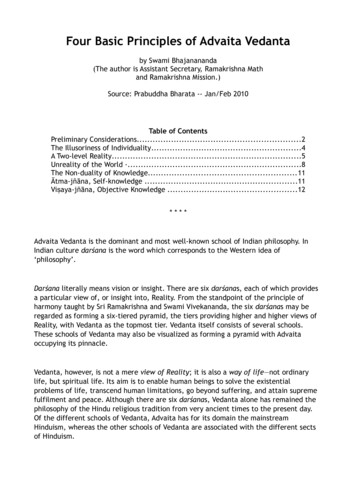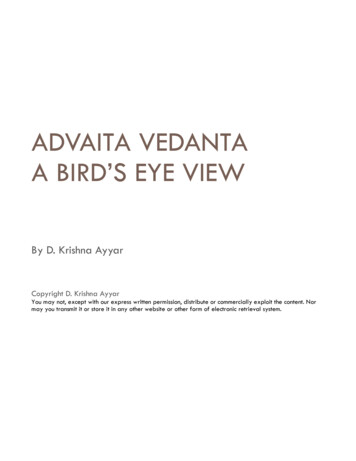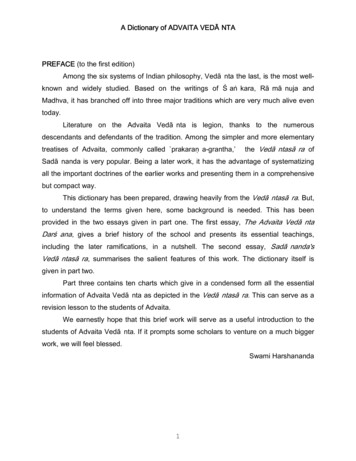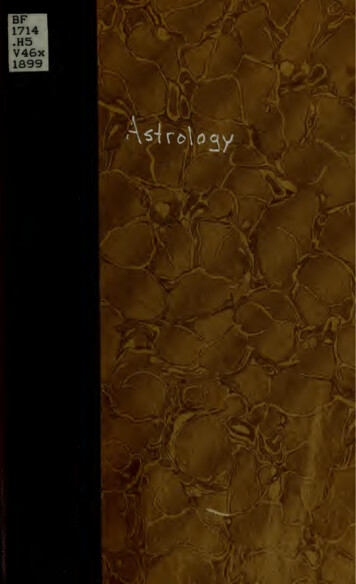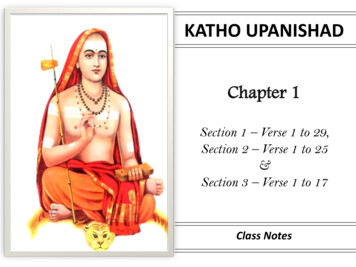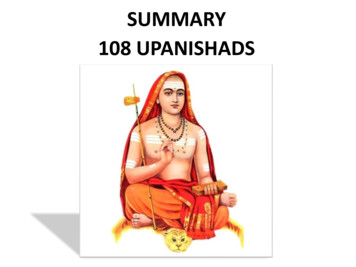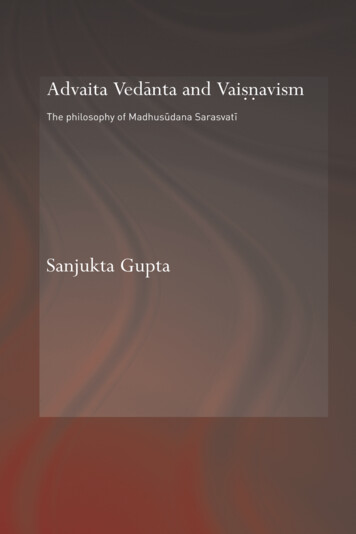
Transcription
ADVAITA VEDANTA AND VAISJAVISMIn Indian philosophy and theology, the concept of Brahman postulated by Vedantaoccupies an important position. Hindu religious sects accept the Vedanticsoteriology which believes that there is only one conscious reality, Brahman, fromwhich the entire creation, both conscious and non-conscious, emanated.Madhusudana Sarasvati, who lived in sixteenth-century Bengal and wrote inSanskrit, was the last great thinker in the Vedanta tradition. During his time,Hindu sectarians came to reject monistic Vedanta. Although a strict monist,Madhusudana tried to forge a synthesis between his monistic philosophy andhis theology of emotional love for God. This book expounds the main tenets ofhis extensive and difficult works and represents the only comprehensive study ofMadhusudana Sarasvati’s thought.Sanjukta Gupta taught at Visva Bharati University, Calcutta University andJadavpur University in India, as well as Utrecht University in the Netherlands. Atpresent she is a member of the Oriental Institute at the University of Oxford. Shespecialises in Indian philosophy with a focus on the system of Vedanta in Hindutheology, in particular Vaisjavism and Tantra.
ROUTLEDGE HINDU STUDIES SERIESSeries Editor: Gavin Flood, University of StirlingFormer Series Editor: Francis X. Clooney, S.J.,Harvard UniversityThe Routledge Hindu Studies Series, in association with the Oxford Centre forHindu Studies, intends the publication of constructive Hindu theological,philosophical and ethical projects aimed at bringing Hindu traditions intodialogue with contemporary trends in scholarship and contemporary society. Theseries invites original, high quality, research level work on religion, culture andsociety of Hindus living in India and abroad. Proposals for annotated translationsof important primary sources and studies in the history of the Hindu religioustraditions will also be considered.EPISTEMOLOGIES AND THE LIMITATIONS OFPHILOSOPHICAL INQUIRYDoctrine in Madhva VedantaDeepak SarmaA HINDU CRITIQUE OF BUDDHIST EPISTEMOLOGYKumarila on perceptionThe ‘determination of perception’ chapter ofKumarilabhatta’s SlokarvarttikaTranslation and commentaryJohn TaberSAMKARA’S ADVAITA VEDANTAA way of teachingJacqueline HirstATTENDING KRSJA’S IMAGECaitanya Vaisjava murti-seva as devotional truthKenneth Russell ValpeyADVAITA VEDANTA AND VAISJAVISMThe philosophy of Madhusudana SarasvatiSanjukta Gupta
ADVAITA VEDANTA ANDVAISNAVISMThe philosophy of Madhusudana SarasvatlSanjukta GuptaR !!;" . ;"PLONDON AND NEW YORK
First published 2006by Routledge2 Park Square, Milton Park, Abingdon, Oxon OX14 4RNSimultaneously published in the USA and Canadaby Routledge711 Third Ave, New York, NY 10017Routledge is an imprint of the Taylor & Francis Group,an informa business 2006 Sanjukta GuptaTypeset in Times New Roman byNewgen Imaging Systems (P) Ltd, Chennai, IndiaAll rights reserved. No part of this book may be reprinted orreproduced or utilised in any form or by any electronic,mechanical, or other means, now known or hereafterinvented, including photocopying and recording, or in anyinformation storage or retrieval system, without permission inwriting from the publishers.British Library Cataloguing in Publication DataA catalogue record for this book is availablefrom the British LibraryLibrary of Congress Cataloging in Publication DataGupta, Sanjukta.Advaita Vedanta and Vaishnavism : the philosophy of MadhusudanaSarasvati / Sanjukta Gupta.p. cm. – (Routledge Hindu studies series)Includes bibliographical references and index.1. Madhusudana Sarasvati. 2. Advaita. 3. Vaishnavism. I. Title.II. RoutledgeCurzon Hindu studies series.B133.M184G87 2006181'.482–dc222006006814ISBN10: 0–415–39535–6 ISBN13: 978–0–415–39535–9 (hbk)ISBN10: 0–203–96970–7 ISBN13: 978–0–203–96970–0 (ebk)
CONTENTSPrefaceSeries prefaceviiix1Introduction12Avidya143Knowledge and epistemology444Brahman655The sentient world: Ifvara, Jiva and Saksi846Material world and cosmogony1007Advaita-vedanta ex145147167173v
PREFACEThis book is based on my 1958 PhD thesis written at Visva Bharati Universityand published in India in 1966. It addressed mainly Indian scholars of ancientIndian Darfana Fastra (philosophy). For a long time I wanted to re-edit and updateit. My great friend the late Mrs Coomee Strooker of Amsterdam started to read itthrough in order to correct my English, but unfortunately age prevented her fromcompleting the task. That was decades ago. I just mention her to express my deeprespect and love for her.To my great surprise Rishi Shaunaka Dasa, Director of the Oxford Centre forHindu Studies, one day offered to publish this work in his Series of HinduReligious Studies. I am grateful for this generous offer. He also introduced me tothe Centre’s secretary, Ms Diane Rollinson, who in her amazing kindness typedup my thesis on the Centre’s computer. But for her I would never have been ableto reshape my old work on Madhusudana Sarasvati. I am also indebted toDr Sarah Shaw for reading and correcting my thesis and Mr Tamal Matilal whosecareful proofreading and many suggestions for improvement have been invaluable. I thank Professor Francis X. Clooney, S.J., the former chief editor of theRoutledge Hindu Studies Series, for accepting my book for publication. I mustalso thank Professor Godavarisha Misra for his constant encouragement.Ms Dorothea Schaefter, Associate Editor at Routledge has also been most helpful.Sanjukta Guptavii
SERIES PREFACEThe Routledge Hindu Studies Series, published in collaboration with the OxfordCentre for Hindu Studies, intends primarily the publication of constructive Hindutheological, philosophical and ethical projects. The focus is on issues and concerns of relevance to readers interested in Hindu traditions in particular, yet alsoin the context of a wider range of related religious concerns that matter in today’sworld. The Series seeks to promote excellent scholarship and, in relation to it, anopen and critical conversation among scholars and the wider audience of interested readers. Though contemporary in its purpose, the Series recognises theimportance of retrieving the classic texts and ideas, beliefs and practices, ofHindu traditions, so that the great intellectuals of these traditions may as it werebecome active participants in the conversations of today. Deepak Sarma’sEpistemologies and the Limitations of Philosophical Inquiry, John Taber’s AHindu Critique of Buddhist Epistemology: Kumarila on Perception, JacquelineHirst’s Samkara’s Advaita Vedanta: A Way of Teaching, and Kenneth RussellValpey’s Attending Krsja’s Image: Caitanya Vaisjava Murti-seva as DevotionalTruth have been the distinguished first four volumes in the Series.Sanjukta Gupta’s Advaita Vedanta and Vaisjavism: The Philosophy ofMadhusudana Sarasvati is now published as our fifth volume. It is an exhaustivestudy of the writings of Madhusudana Sarasvati, a prominent sixteenth-centuryHindu theologian and philosopher who delved deeply and expertly into bothAdvaita Vedanta and Bengali Vaisjavism. The publication of this work in theSeries reflects our recognition that this important figure has been inadequatelystudied and deserves more attention. Moreover, by studying him we also fill outour understanding of Advaita and dispel exaggerations regarding the relationshipsand differences between Advaita and Vaisjavism.Our decision to include Advaita Vedanta and Vaisjavism in this Series is alsoin-keeping with our determination to make available to readers, when theopportunity arises, important works that have long been out of print. OriginallyDr Gupta’s 1958 dissertation (Visva Bharati University) and published in 1966 asStudies in the Philosophy of Madhusudana Saraswati (Calcutta: Sanskrit PustakBhandar), Advaita Vedanta and Vaisjavism is still our primary source for detailedand exhaustive information on a most important Hindu thinker. We are also happyix
SERIES PREFACEto note that Dr Gupta has revised and updated her work in order to make it moreeasily accessible to the contemporary reader.Advaita Vedanta and Vaisjavism is thus a solid and rare resource for the historyof Hindu theology. It is, we hope, a basis for additional constructive writing onMadhusudana Sarasvati, who deserves still further study, and on Advaita Vedantaand Bengali Vaisjavism as well. Accordingly, the book accomplishes very wellgoals that are central to a Hindu Studies Series focused on bringing the treasuresof the Indian and Hindu traditions into the contemporary conversation of studentsof Hinduism, theologians and scholars of religion.Francis X. Clooney, S.J.Routledge Hindu Studies Series Editor 2002–2005Parkman Professor of DivinityHarvard Universityx
1INTRODUCTIONA sixteenth-century Bengali philosopher of Advaita-Vedantaand theologian of KrsjabhaktiAccording to the tradition Madhusudana Sarasvati of the sixteenth century CErose to great eminence even during his own life time. Madhusudana, a monk, wasa follower of FaÅkara’s non-dualist school of Vedanta. He was an outstandingpolemic writer and wrote many commentaries and independent treatises on nondualist Vedanta philosophy. He was also a great theologian and composed anextended commentary on the Bhagavadgita and a commentary on the first verseof the Bhagavata Puraja and a monograph on the bhakti theology, the BhaktiRasayana. He was a renowned philosopher who was proficient in all systems oftraditional Indian philosophy. According to tradition he first studied the traditionaland contemporary system of logic, Nyaya-Vaifesika and developed a powerfulpolemical style popular amongst the philosophers of his time. He was a formidable writer on the Advaita-Vedanta dialectics. As a theologian of the Bhagavataschool of bhakti he stands unique even though he was close to the Vaisjava theologians of the Bengal school of Vaisjavism promulgated by the followers ofFrikrsja Caitanya of Navadvipa in Bengal. He seems to have continued the tradition of the bhakti theology of Fridhara and Bopadeva, (thirteenth century CE), twovery important commentators on the Bhagavata Puraja (BP) who attempted tointerpret the religious position of the BP in the light of monism. As the traditionwould have it he was a great admirer of Caitanya but there is no mention of himin any of his works. Nor does he indicate any adherence to the special theologyof the Caitanya-school. Nevertheless, as part of the intellectual milieu of his time,he must have known Caitanya’s life and activities. Madhusudana’s description ofa Vaisjava devotee who has achieved a devotee’s goal that is, the state of constantenjoyment of ecstatic devotion for Krsja reminds one strongly of the traditionalpicture of Caitanya in constant ecstasy. I think it is Madhusudana’s intellectualloyalty to FaÅkara’s non-dualistic Vedanta that prompted him to develop his owntype of Vaisjava theology. Thus, though he stands alone in his interpretation ofnon-dualistic philosophy of bhakti based on the Bhagavata Puraja, he has forgeda bridge between the FaÅkara-school of philosophy and the Caitanya’s school of1
INTRODUCTIONtheology. I should like here to show the important position of MadhusudanaSarasvati in the historical development of metaphysical and religious ideas of hisperiod.The works of Madhusudana reveal him to be a versatile genius, a faithfulcommentator, an independent writer on FaÅkara’s school of monism as well asan upholder of the concept of bhakti. Not only did he synthesise the differentschools of the Advaita-Vedanta, but he also chalked out a new path of his ownagainst the heaviest odds of two different streams of dualism – logicians on theone hand and the Madhva-Vaisjavas on the other. His unique contribution toIndian philosophy is his attempt to visualise a union between absolute monismand devotionalism.Madhusudana occupies an important position amongst the Vaisjavas of histime. Fridhara and Vopadeva, already introduced a new wave of Vaisjavism basedon the BP, which developed a bhakti mysticism based on the concept ofUpanisadic unqualified, immutable, ineffable, Brahman adapted to a personalgodhead, Narayaja or indeed Krsja. The importance of the first verse of BP to itsmonistic commentators is indeed great and Madhusudana underscored it by himself commenting on that verse. But the Vaisjava theology clashed againstFaÅkara’s concept of maya or avidya which is just a positive category, yet isillusion. It is a category on its own, being neither existent nor, non-existent. It isbeginningless but is finite. World is a creation of this illusion, avidya and not ofBrahman, the uniquely existent reality. Being a creation of avidya (or maya) theworld of living and non-living beings is false.Madhusudana appeared at the height of the great controversy amongst theIndian philosophers over the question of the illusoriness of the empirical world.Philosophers of all other systems contested the notions of the illusoriness of theworld and of maya/avidya/ajñana, which is the source of this illusion. Thephilosophers like the ritualist MimaÅsakas and the SaÅkhya and the NyayaVaifesika realists, on the one hand, and the theologians of the various sects whobelieved in the reality of God’s creation, on the other, all attacked FaÅkara’stheories based on illusion.Majdana Mifra, FaÅkara’s contemporary and a follower, refuted many ofthese attacks on the concepts of avidya along with Surefvara and other early nondualists. The great Nyaya philosopher Udayana launched a severe attack on theconcept of non-dualism. His famous work, the Nyaya-kusumañjali, successfullyestablished the reality of the creation and its material source. One aspect of theimportance of Udayana is his great style of disputation based on logicalargumentations. Fri Harsa (twelfth century CE) took up the challenge and usingthe same style of disputation attacked the Nyaya Vaifesika realism in his workthe Khajdana-khajda-khadyam.
ADVAITA VEDANTA AND VAISJAVISM In Indian philosophy and theology, the concept of Brahman postulated by Ved anta occupies an important position. Hindu religious sects accept the Vedantic soteriology which believes that there is only one conscious reality, Brahman, from which the entire creation, both conscious and non-conscious, emanated. Madhusudana Sarasvati, who lived in
